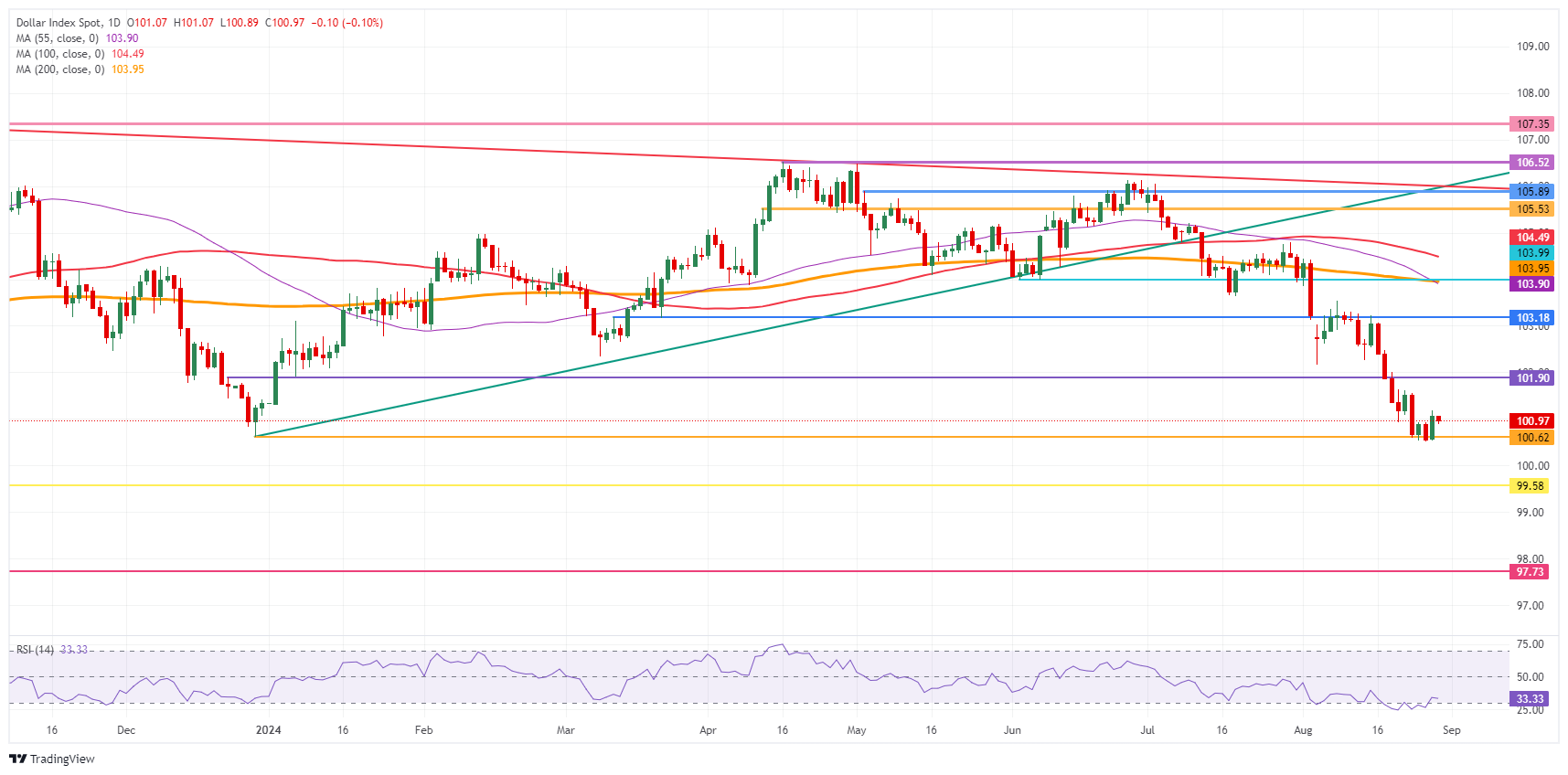US Dollar consolidates ahead of key US economic data
- The US Dollar trades on the back foot, weakening against most major peers, as traders focus on key US data.
- Markets cramped on Wednesday on the back of a miss in estimates for Nvidia earnings, benefiting the Dollar.
- The US Dollar Index popped above 101.00, but is unable to hold this level.
The US Dollar (USD) trades broadly unchanged on Thursday, easing somewhat against most of its peers, failing to extend Wednesday’s gains. The USD faces two days of a busy US economic calendar, with some data having the potential to be market-moving. Expect to see volatile moves unfolding as markets constantly flip-flop between bets of a 25-basis-point or a 50-basis-point interest-rate cut in September, depending on how incoming economic data plays out. Federal Reserve (Fed) Jerome Powell didn’t commit to any rate-cut size or forward guidance in his speech at Jackson Hole, so markets will have plenty of variables to speculate with.
On the US economic calendar front, a rough patch in terms of volatility will be offered this Thursday. Besides the weekly Jobless Claims, the second reading of the US Gross Domestic Product (GDP) will be released for the second quarter. The Personal Consumption Expenditure (PCE) number under that GDP umbrella will get a lot of attention ahead of the monthly PCE numbers on Friday.
Daily digest market movers: Hold on tight
- Inflation data from both Germany and Spain showed an intensifying disinflation trend, with even some German provinces posting price declines on a monthly basis. This triggered a sharp move lower for the Euro (EUR) against the US Dollar (USD), erasing nearly all gains booked last week.
- At 12:30 GMT, a chunky batch of data will be released:
- Weekly Jobless Claims for the week ending August 23:
- Initial Claims are expected to hold steady at 232,000.
- Continuing Claims were previously at 1.863 million.
- US Gross Domestic Product for the second quarter will see its second estimate, with economists not expecting any significant revisions:
- Headline GDP is expected to have grown at an annualised rate of 2.8% as previously estimated.
- The headline Personal Consumption Expenditure (PCE) Prices component is expected to come in at 2.6%, unchanged from the first reading. The Core PCE isn’t expected to be revised either from the 2.9% previously reported.
- The GDP Price Index component was at 2.3% in the first reading, with no forecast available for the second reading.
- Wholesale Inventories for July should grow by 0.2%, the same increase as in June. The Goods Trade Balance, meanwhile, is expected to widen slightly to $97.5 billion from $97.4 billion.
- Weekly Jobless Claims for the week ending August 23:
- At 14:00 GMT, Pending Home Sales for July will come in. Expectations are for sales to increase by 0.4%, down from the 4.8% rise seen a month earlier.
- Around 19:30, comments are expected from Federal Reserve Bank of Atlanta President Raphael Bostic, who delivers a presentation and participates in a Q&A about the Federal Reserve and the US economic outlook to Georgia Tech's Scheller College of Business Management of Financial Institutions class.
- Equities are trading flat in Asia, looking for directions after markets branded the Nvidia earnings report as a miss. European and US equities are trading flat to minor losses.
- The CME Fedwatch Tool shows a 65.5% chance of a 25 basis points (bps) interest rate cut by the Fed in September against a 34.5% chance for a 50 bps cut. Another 25 bps cut (if September is a 25 bps cut) is expected in November by 44.2%, while there is a 44.6% chance that rates will be 75 bps (25 bps + 50 bps) below the current levels and an 11.2% probability of rates being 100 (25 bps + 75 bps) basis points lower.
- The US 10-year benchmark rate trades at 3.84%, not that far off its peak for this week near 3.87%.
US Dollar Index Technical Analysis: You get what you give
The US Dollar Index (DXY) could enter a rough volatile patch in the coming 48 hours with a bulk load of data making its way to markets. That the DXY is set to make some whipsaw moves is due to the Fed not committing to the size of its initial rate cut and also not clarifying if this is the start of a rate cutting cycle or could still end in a one-and-done cut. Markets were euphoric last week, and clearly have tuned down that cheerful mood with the DXY becoming the barometer on how markets foresee the next steps of the Fed.
For a recovery, the DXY faces a long road ahead. First, 101.90 is the level to reclaim. A steep 2% uprising would be needed to get the index to 103.18. A very heavy resistance level near 104.00 not only holds a pivotal technical value, but it also bears the 200-day Simple Moving Average (SMA) as the second heavyweight to cap price action.
On the downside, 100.62 (the low from December 28) tries to hold support, although it looks rather feeble. Should it break, the low from July 14, 2023, at 99.58 will be the ultimate level to look out for. Once that level gives way, early levels from 2023 are coming in near 97.73.

US Dollar Index: Daily Chart
US Dollar FAQs
The US Dollar (USD) is the official currency of the United States of America, and the ‘de facto’ currency of a significant number of other countries where it is found in circulation alongside local notes. It is the most heavily traded currency in the world, accounting for over 88% of all global foreign exchange turnover, or an average of $6.6 trillion in transactions per day, according to data from 2022. Following the second world war, the USD took over from the British Pound as the world’s reserve currency. For most of its history, the US Dollar was backed by Gold, until the Bretton Woods Agreement in 1971 when the Gold Standard went away.
The most important single factor impacting on the value of the US Dollar is monetary policy, which is shaped by the Federal Reserve (Fed). The Fed has two mandates: to achieve price stability (control inflation) and foster full employment. Its primary tool to achieve these two goals is by adjusting interest rates. When prices are rising too quickly and inflation is above the Fed’s 2% target, the Fed will raise rates, which helps the USD value. When inflation falls below 2% or the Unemployment Rate is too high, the Fed may lower interest rates, which weighs on the Greenback.
In extreme situations, the Federal Reserve can also print more Dollars and enact quantitative easing (QE). QE is the process by which the Fed substantially increases the flow of credit in a stuck financial system. It is a non-standard policy measure used when credit has dried up because banks will not lend to each other (out of the fear of counterparty default). It is a last resort when simply lowering interest rates is unlikely to achieve the necessary result. It was the Fed’s weapon of choice to combat the credit crunch that occurred during the Great Financial Crisis in 2008. It involves the Fed printing more Dollars and using them to buy US government bonds predominantly from financial institutions. QE usually leads to a weaker US Dollar.
Quantitative tightening (QT) is the reverse process whereby the Federal Reserve stops buying bonds from financial institutions and does not reinvest the principal from the bonds it holds maturing in new purchases. It is usually positive for the US Dollar.

